Finally, a new article for the Deep Doujin Dive series, in which we delve into obscure, rare, non-mainstream or not very well known Japanese fighting games and review their mechanics, aesthetic, and appeal. This time, we are talking about a limited time demo of an upcoming remake, Phantom Breaker: Omnia, developed by MAGES Inc. and published by Rocket Panda Games!
GATE OF STEINER
A disclaimer, first and foremost: I loved Steins;Gate. Full stop. For a short period of my life, I was even kind of obsessed with it, down to watching the OVA movie in German — when I was still in the process of learning the language. As a physicist (yes, I have a Ph.D. and I worked at SERNCERN as a member of an antimatter experiment from 2013 to 2018), I had to turn my willing suspension of disbelief up to eleven, but I have no regrets. The story was gripping and I loved every second of it.
You can imagine my surprise when I found out that Kurisu Makise from the aforementioned visual novel was… huh, a playable guest character in a 2011 fighting game developed by MAGES Inc. That game was Phantom Breaker, and — to my chagrin — it was released only on Xbox360 and PS3, consoles from a generation I skipped completely. Okay, on PC we got a chibi beat’em up spin-off based on said game, but it’s not really the same thing.
Despite my original interest, I quickly forgot about it, only to find out that Phantom Breaker was going to have an updated re-release in 2022, thanks to a new publisher, Rocket Panda Games… and that said game would have had a public, free demo to test, at least until 28 February!
El Psy Kongroo
A new old story
Before I start with my impressions on the demo, I need to address the elephant in the room: Omnia is not a plain remaster of Extra, which might or might not be a good thing.
According to a couple players I have asked, the original Phantom Breaker: Extra was already quite okay in terms of balance and variety, and needed only some minor changes and quality of life improvements (for example, a functioning rollback netcode). However, Phantom Breaker: Omnia went in a completely unexpected direction, changing the game system down to the fundamentals. Whether this will be good or not, only time and labbing will tell.
Since I have not played the original game, I will talk only about Omnia. The interested readers will find a full rundown of the changes in this video and in this Mizuumi wiki page, courtesy of Keobas, who also acted as a consultant for this article.
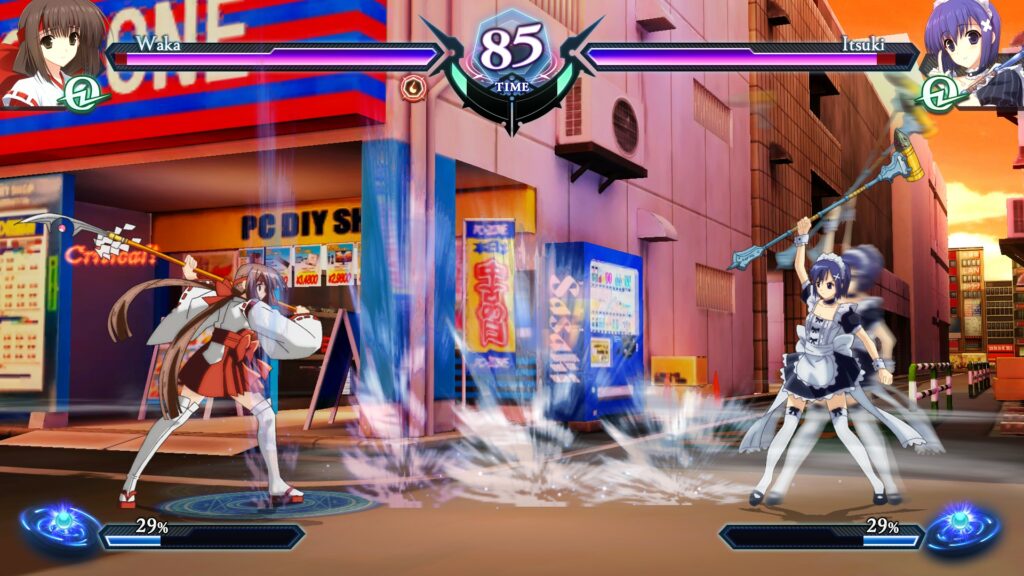
Just an ordinary day in the streets of Akihabara, where a miko with a naginata fights a maid with a Bullet Bill hammer… and, wait, am I hearing the Steins;Gate theme?!
A rocky start
System changes aside, the fact that the game won’t have rollback netcode had players already worrying about it being “dead on arrival”. The bombastic announcement trailer didn’t help to quench my preoccupation. If anything, it amplified it, because it was at the same memetic level of the infamous trailers for Might No. 9 and the more recent “I’M HERE TO KILL CHAOS” Stranger of Paradise.
All things considered, the game seems to have a fair amount of obstacles in front of it. However, I wanted to give it a fair chance, thus I have approached the game with an open mind, controller in hand, and booted up the demo.
Our producer "SakariP" @OtherGuyX shared his thoughts on Rollback Code in regards to #PhantomBreakerOmnia. We've gone ahead and translated his thread in the image below. https://t.co/6XVs96A8FO pic.twitter.com/ieyfjjRs0L
— Rocket Panda Games 🧡 #FGC (@RocketPandaEN) November 25, 2020
Wait, have you really said “Italian localization”?!
When the game started, I was pleasantly surprised by the presentation. The soundtrack is very atmospheric and on par with what I would have expected from a MAGES Inc. production. It is possible to switch between the original one used in Extra and the new Omnia arrangement, which is a plus for those who used to play the 2011 version. Moreover, I was supremely shocked to find out that the game had been localized in Italian too, down to the tutorials and guides.
Now, in the 90s and early 00s it wasn’t unheard of for a relatively minor game to have an Italian localization (some quite decent and some that I’d rather forget instead) but for a port of a niche 2011 fighting game? This was totally unexpected and very welcome.
Nowadays, I play most of my games in English, but having this level of accessibility is a plus in my book, especially because south European countries still have a relatively low level of English knowledge (source: Eurostat). While for most competitive players this is a non-issue, this might actually be helpful as a way to break into a wider, more casual market.
Alongside Italian, the game is localized in English, French, German, Spanish, Japanese, and two variants of Chinese, for a grand total of eight supported languages. The audio has been localized to English too, alongside the original Japanese voice lines. Since apparently this game will have a story mode with a decent amount of text, this is a commendable effort to try and reach out for an international audience.
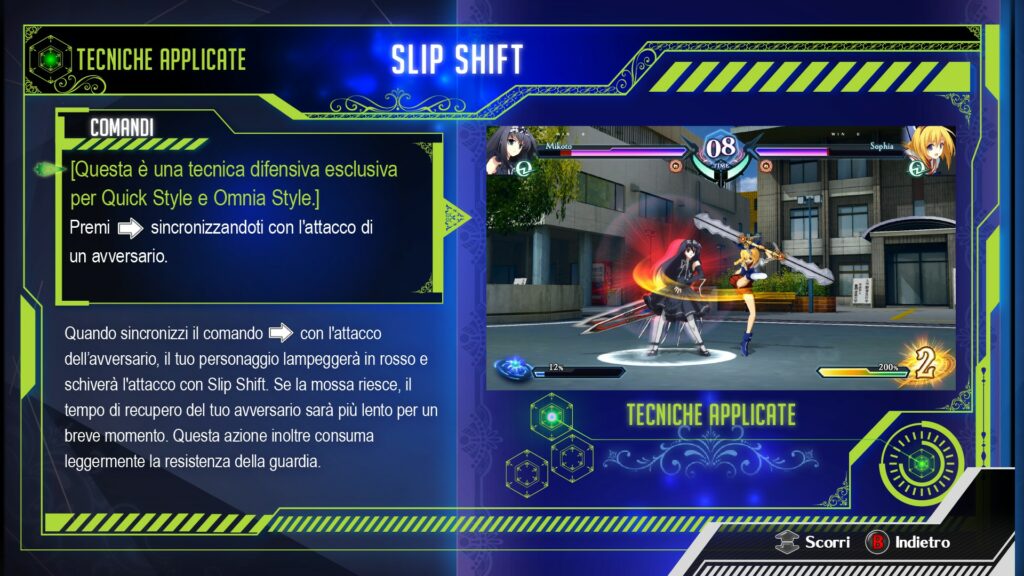
The game’s guide is localized in eight languages, including Italian. It was a pleasant and shocking surprise, as I would expect this kind of care for non-English speakers only for bigger production and AAA games.
Demo demons
Before delving into the game mechanics, two words on the current package: the demo contains four characters and a huge number of stages. Only the game guide, settings and versus mode can be accessed. Versus mode contains both local versus, player vs AI and AI vs AI.
Training mode is an unexplainably missing feature. Even games like Pocket Bravery, Drag Her! and Blazing Worldstars, which are comparable in terms of content, had a freely accessible training mode, which allowed to lab some combos and test some setups. Phantom Breaker: Omnia doesn’t. This is the most glaring deficit of the current demo, from a competitive point of view. What makes it even more daunting is the fact that this game has neutral auto guard, so even setting up a versus match to test some combos would make things very uncomfortable, due to the dummy blocking every standing attack by default.
The demo has also no online modes whatsoever, but this is more understandable in my opinion.
One thing that needs to be mentioned and isn’t immediately clear when booting it up, is that the game can be played on a keyboard: One just needs to press Enter in the start screen or in the VS mode selection screen. Both Xbox and off-brand DirectInput joypads worked fine too during my test, which means that Phantom Breaker: Omnia should support most arcade sticks and peripherals out there. It’s not 100% clear if split keyboard is an option for two players. I couldn’t manage to activate it, despite pressing virtually every key, thus I assume that it is not a thing.
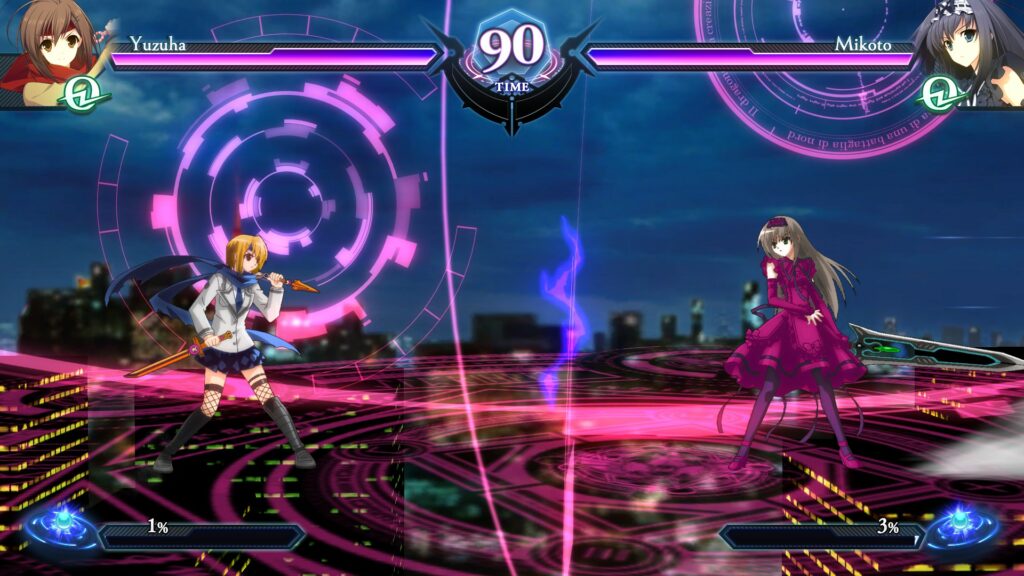
Some of the stages are positively jaw-dropping. My favorite was the “above Tokyo at night”, but I can’t name a bad stage background. Moreover, every stage has several different variants that alternate depending on the round.
A simplified core with tons of mechanics
Now that we have gone through the quirks of this time-limited demo, let’s delve a bit into the game proper.
Phantom Breaker: Omnia presents itself as a simplified fighting game with several layers of additional depth. There are four main buttons — Light, Medium, Heavy, and Special —with some macros for specific defensive or offensive maneuvers. Grabs are performed by pressing towards or away plus Heavy attack while near the opponent. Some of the buttons can be mashed to perform a string of attacks, even on whiff, much like autocombos in Dragon Ball FighterZ.
There are no motion inputs, all specials are performed by pressing a direction plus one or two additional buttons. Each special move has three variants: A light version, performed by pressing a direction together with the Light and Special button; a normal version, performed by pressing a direction together with the Special button; an EX version, accessed by pressing the Heavy and Special button together with a direction, that consumes one stock of Burst gauge and has improved damage or utility.
Pressing the Special button alone triggers an armored attack that can absorb one of the opponent’s attack or clash against it. This attack can be held down to become an unblockable launcher. Using the Special button in the air will trigger a similar attack, but without the possibility to charge it.
One important note about movement: despite basking in anime tropes, this game is not an air-dasher. There is a double jump, accessible in certain Styles, but that’s it. This, combined with the relatively slow walking speeds, makes Phantom Breaker feel far more grounded than other, more traditional anime fighters.
Burst gauge is this game’s super meter, and — contrary to what happened in its predecessor Phantom Breaker: Extra — carries over between rounds.
One interesting feature is the so-called Tension gauge, which is unique to this game’s series, as far as I know. Tension gauge is a shared indicator between players and is filled by clashing attacks with your opponent. When the Tension gauge is full, both characters will start gaining Burst gauge and receive a damage boost until the bar is depleted. You can think about it as a more controlled, on-demand Guilty Gear Xrd Rev2 Danger Time (yes, THAT danger time), except without the exaggerate one-interaction-kill potential. During this time frame, fully charging the Special attack will unleash an unblockable launcher that, on hit, will cause a wall bounce for some impressive damage.
As additional universal mechanics go, there is also a defensive burst, which can be activated after being hit by two or more attacks and consumes the Burst gauge, guard break (ominously foreshadowed by the guard effect turning red) and a classic stun system (signaled by the character portrait flashing yellow). This game implements also a neutral guard system: Pressing nothing or keeping back pushed will block all standing attacks, while to block low attacks, one needs to input down plus back.
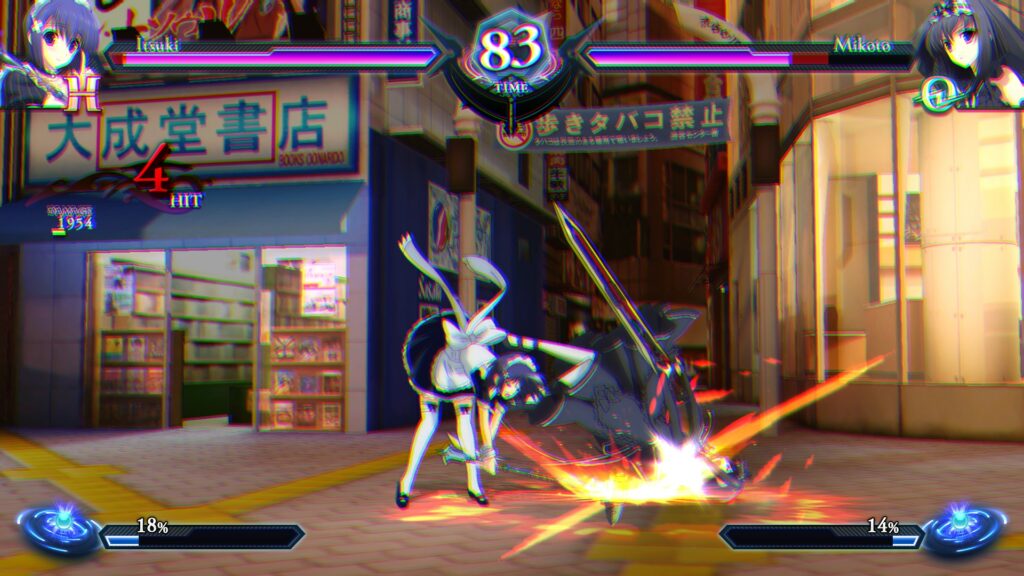
Not gonna lie, the impacts of some moves are extremely satisfying and “sell” the hits well. The Shibuya stage reminds me a bit of the book store one can visit in The World Ends With You. I wonder if that’s the same spot in front of the scramble crossing…
Fighting with style
Phantom Breaker: Omnia features three different styles with additional sub-systems and perks:
- Quick:
- increased speed but decreased defense;
- has a double jump;
- one can mash the Light, Medium or Heavy attack for an autocombo, even on whiff;
- has a sort of “time stop parry”, accessed by pressing forward while the opponent attacks;
- has a “Clock Up” mode with full bar that allows a character to chain any attack into any other attack, even on whiff, for a limited amount of time. When this install is over, Burst gain will be halted for a handful of seconds;
- has access to a Phantom Breaker super that uses up 200% Burst gauge; it’s a very damaging move, but after being performed will stop Burst gain for a handful of seconds.
- Hard:
- increased defense at the cost of speed;
- one can mash the Heavy attack button for an autocombo, even on whiff, but loses Light and Medium autocombos;
- has access to a unique back Medium normal move;
- has a more standard parry instead of the evasion mechanics of Quick, accessed by pressing forward while the opponent attacks;
- has a “Solid Armor” install mode with full bar that gives the character hyper armor and increased damage for a limited amount of time. When this install is over, Burst gain will be halted for a handful of seconds;
- has access to a different Phantom Breaker super than Quick, which seems to be complementary to it.
- Omnia:
- average stats;
- has a double jump;
- can build up to 400% Burst gauge;
- access to Light, Medium, Heavy autocombos;
- has a sort of “time stop parry”, accessed by pressing forward while the opponent attacks;
- has no access to any installs or Phantom Breakers;
- has a full range screen attack similar to what is seen in the spin-off Phantom Breaker: Battle Grounds, which deals massive damage even on block and uses up the full 400% Burst gauge.
Despite the bizarre clash system and the three different styles, the game is fairly easy to pick up and play and allows for a satisfying casual experience. I cannot judge the competitive viability of this game, though, as I couldn’t try it out against more experiences players during my test.
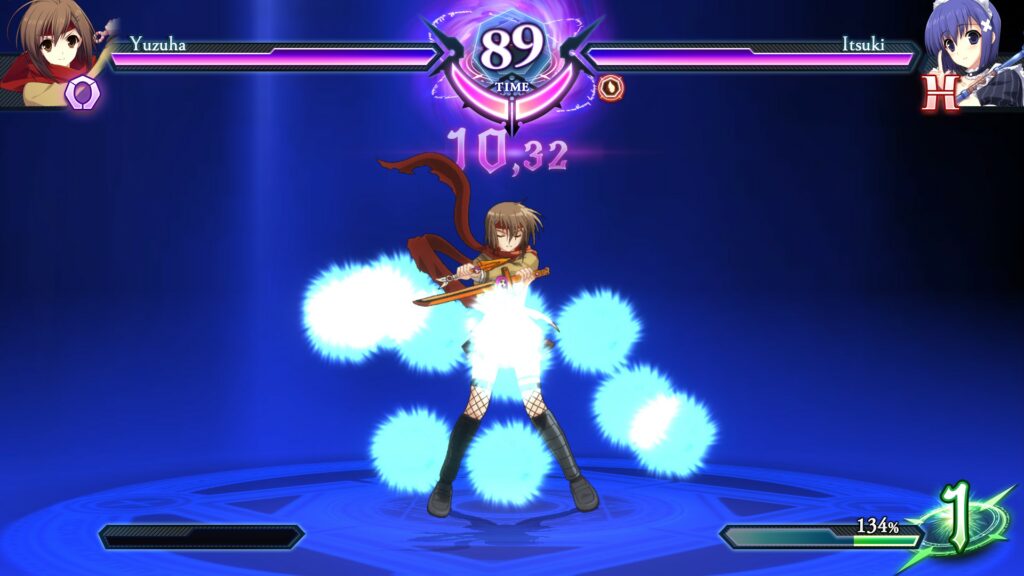
The All-Range attack is one of the additions to the Omnia style. It consists in a shower of projectiles that consume 400% of the Burst meter and deals insane damage both on hit and block. This attack was first featured in the beat’em up spin off “Phantom Breaker: Battle Grounds“
Whom is this game for?
This is a tricky question. During my time with the Phantom Breaker: Omnia demo, I couldn’t help by having contrasting feelings. On the one hand, playing in the Akihabara stage with Kurisu’s theme on repeat while trading blows with the AI was quite the experience. The character sprites are nicely drawn, the stages are positively gorgeous, reminding of the urban atmospheres of Under Night In-Birth and Arcana Hearts 3. The movement feels snappy and the controls feel very responsive. I had the most fun while playing Yuzuha, the resident ninja with a red scarf, with her evasive moves, shuriken toss and the classic izuna drop™.
On the other hand, the AI was very passive and not exactly a challenge at normal difficulty, the character design might be very unappealing for a consistent portion of players (the demo features a gothic lolita with a big sword, a priestess with a naginata, a maid with a hammer and a ninja with a school uniform), and the spline animations in the super cut-ins feel “cheap”. Some animations are bit rough too, like Waka’s standing light attack, which looks like anything except an attack.
There are also some missing quality of life features, like a rematch button after a VS match is over (at least in the demo) and we know for sure that the game will run on standard delay netcode.
Overall, it’s hard for me to answer to this question. In my personal opinion, Phantom Breaker: Omnia could be an almost perfect casual experience due to the massive planned cast and the overall good presentation but might struggle to cut its own spot in the competitive scene, both for the fact that it’s not a plain remaster of Extra and the absence of a solid netcode.
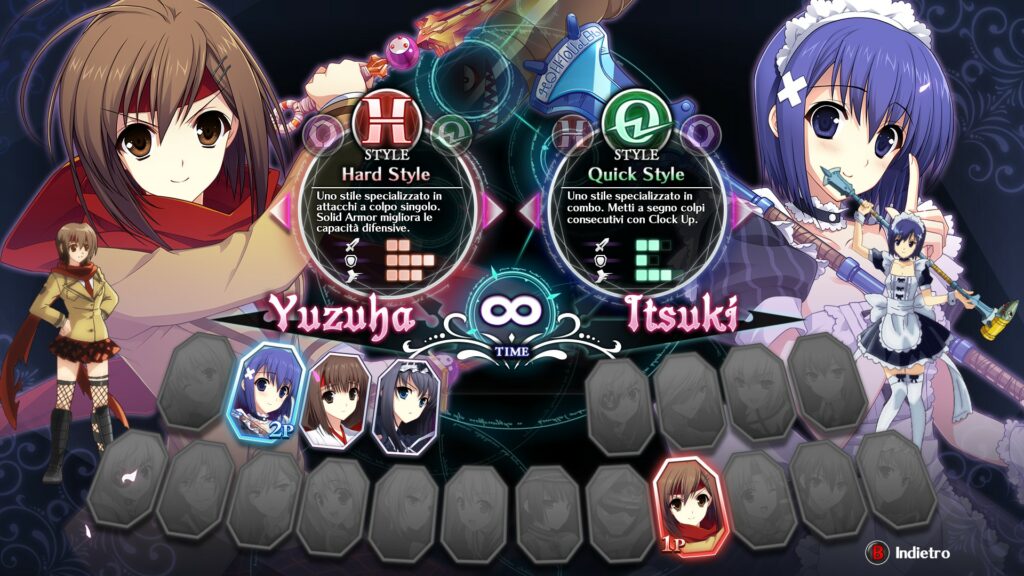
The time-limited demo contains four characters and what I suppose are all the available stages. Shame that there is no available training mode…
How to play it?
The free demo is available for download on the game’s Steam page and will be only available until the 28th of February, 2022. It’s not clear if the demo will be deactivated later, so I would suggest you to give it a try as soon as possible to gauge your interest in the game before it’s too late!
[Update 20.04.2022: Apparently, the demo is still available for download and was reinstated after the game’s launch sooner this year.]
Game summary
Name of the game: Phantom Breaker: Omnia (Demo)
Developer: MAGES Inc.
Publisher: Rocket Panda Games
Available on: PC (Steam)
Price: Free (demo), 39.99USD (full game)
Year of release: 2022
Engine: unknown
Netcode: none/Steam Remote Play Together (Demo); delay netcode planned for the full release
Status: demo — the full release will be on the 15th of March, 2022
In one sentence: 2D fighting game with a more casual appeal and a good presentation, despite some flaws. The demo misses some important functions, like a training mode, but overall does a good job in presenting the game.
Special thanks to Keobas for guiding me through the differences between Phantom Breaker: Extra and Phantom Breaker: Omnia and providing some very informative videos on the topic.
If you are interested in more coverage about indie fighting games, you can find me on Twitter at @AndreaDProjects

